New perk! Get after it with local recommendations just for you. Discover nearby events, routes out your door, and hidden gems when you sign up for the Local Running Drop.
Trying to pick a new bike helmet when there are hundreds of options can be a daunting task. And while all bike helmets – including road, TT, gravel, and mountain biking – have to meet the same safety standards, that doesn’t mean all helmets are created equal. From fit to durability, weight, ventilation, and protection, there are multiple factors to consider to determine what your next purchase might look like.
Your helmet is literally the only thing between your skull and the pavement in the event of a crash. That’s the most important consideration when choosing the best helmet for triathlon training and racing; after that, we can dive into comfort, ventilation, adjustability, aerodynamic features, and aesthetics. And in an age where we’re all looking to save money, many triathletes are also looking for one helmet that can do it all, instead of purchasing separate helmets for training and racing.
Of course, obtaining a bunch of road and triathlon helmets to find the best one for you is a costly and time-consuming venture, especially when performance bike helmets run into the hundreds of dollars. (Expensive? Yes, but see above, re: your skull.) That’s why we recruited members of the Rocky Mountain Triathlon Club in Denver to put the top road and aero helmets through the paces.
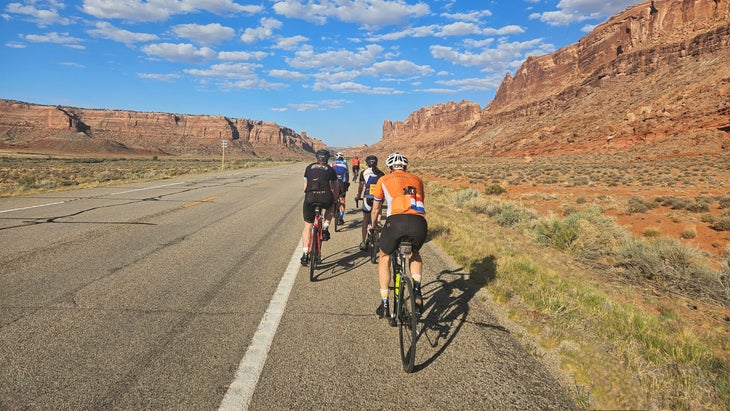
Triathlete’s helmet reviews: The ratings, explained
Our testers took their helmets for a spin through a variety of workouts and races, critically evaluating the features of each in eight categories:
| Fit & Adjustability | Ability to customize fit on chin straps, internal harness, and angle. |
| Comfort | Easy to wear through long rides without pressure or chafing |
| Ventilation | Sweat and heat management in a variety of conditions |
| Safety | CPSC compliance, rotational impact features (such as MIPS), reflective or high-viz colors, LED lights |
| Durability | Ability to jostle around in triathlon gear bags and car trunks without damage |
| Sunglass Compatibility | Design feature to securely hold sunglasses when not in use (or sun visors, if provided) |
| Hearing | Wind blocking and noise clarity of surrounding environment (such as cars or other riders) |
| Value | Value for the price of the product |
| Overall Rating | A combination of the features, functions, and specs above. |
The best road and aero helmets for triathlon
Lazer Vento KinetiCore

| Weight | 290g |
| MIPS | Yes |
| Fit & Adjustability | ★★★★★ |
| Comfort | ★★★ |
| Ventilation | ★★★ |
| Safety Features | ★★★★ |
| Durability | ★★★★★ |
| Sunglass Compatibility | ★★★★★ |
| Hearing | ★★★★★ |
| Value | ★★★★ |
| Overall | ★★★ |
Designed with a “reduced frontal surface area” to increase aerodynamics in a 15-degree angle – where a rider’s head typically goes in a sprint – the Vento KinetiCore performs like an aero helmet in road-helmet form. The innovation continues in the use of Lazer’s proprietary KinetiCore, an integrated rotational impact protection system, a MIPS alternative that’s built into the helmet, rather than added on after manufacturing.
Testers liked the color, fit, and light weight of the helmet, remarking that the straps are thin and the interior of the helmet is flexible, making it easy to fit around hair or sunglasses. However, uneven pressure distribution resulted in “hot spots” on the front of the forehead. Large holes in the front make for great ventilation on hot rides, though a lack of mesh or other covering allows bugs to get in very easily. Though the rechargable LED safety light add-on is a notable feature, battery life is quite limited (falling short of the advertised 54-hour run time) and testers disliked having “one more thing” to charge.
Section dividerAbus Gamechanger 2.0
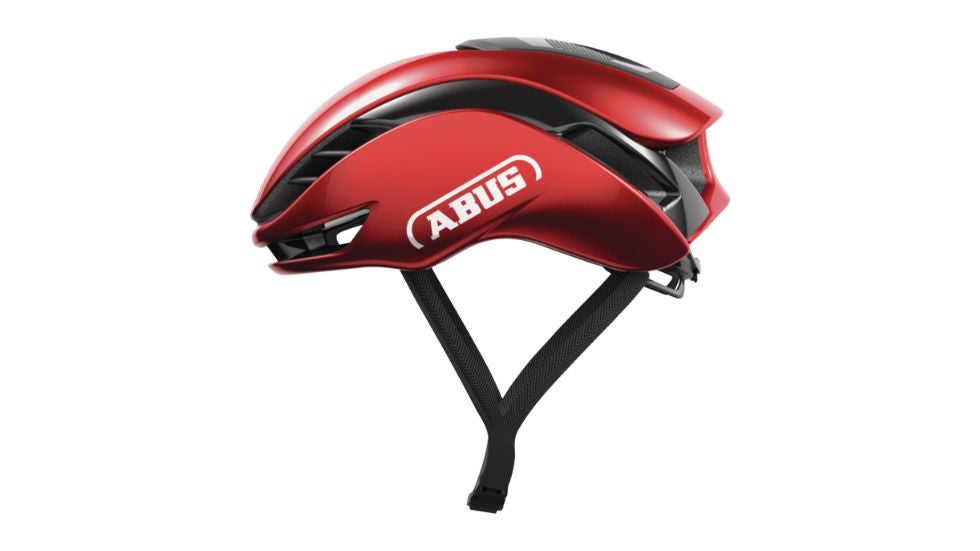
| Weight | 265g |
| MIPS | No |
| Fit & Adjustability | ★★★★ |
| Comfort | ★★★★★ |
| Ventilation | ★★★★★ |
| Safety Features | ★★★ |
| Durability | ★★★★ |
| Sunglass Compatibility | ★★★★★ |
| Hearing | ★★★★★ |
| Value | ★★★★ |
| Overall | ★★★ |
At 265 grams, the Gamechanger 2.0 was the lightest helmet tested. Designed with a wider rear end known as an “AeroBlade,” the GameChanger claims to optimize airflow in every configuration of rider position and wind direction. Indeed, it looks fast and aero: testers remarked this made-in-Italy helmet “came out of the box looking like a red Ferrari” with a sharp design and glossy finish. But on the road, that glossiness turned out to be a distraction, as testers reported the underside of the helmet brim, just above the rider’s eyes, created a distracting reflection just above eye level when the sun was low. There were also concerns about just how well the helmet would hold up in a crash; in addition to lacking MIPS protection, the chin strap began to loosen on rides of three hours or more. This could be easily fixed with a grippier gasket around the strap adjustment point, and this, combined with a no-glare paint job, could take this helmet beyond form to function.
Section dividerRudy Project Wingdream TT
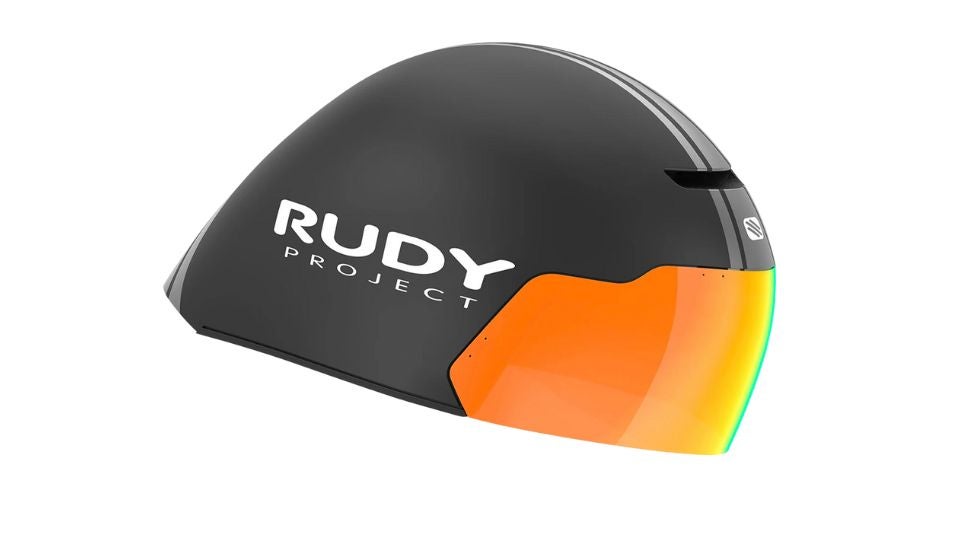
| Weight | 490g |
| MIPS | No |
| Fit & Adjustability | ★★★ |
| Comfort | ★★★ |
| Ventilation | ★★★★★ |
| Safety Features | ★★★ |
| Durability | ★★★ |
| Sunglass Compatibility | ★★★★★ |
| Hearing | ★★★★★ |
| Value | ★★★ |
| Overall | ★★★ |
Triathletes liked the ability to customize their helmet setup with traditional sunglasses or a magnetic sun visor, which is easily attached and secure in all conditions. But the magnetic chin strap is not easy to clasp, and becomes more difficult under stress (in other words, transition). The 490-gram weight felt heavy and clunky, and though the helmet meets CPSC safety certification standards, testers would have liked to see additional safety features like MIPS. At $525, testers were hard-pressed to recommend the helmet, saying they felt it was overpriced compared to other time-trial helmets and there were few outstanding features that justified the cost. Though Rudy Project is notorious for sales with steep discounts, the savings may not be enough to offset the detriments of the helmet.
Section dividerSpecialized S-Works Evade 3

| Weight | 270g |
| MIPS | Yes |
| Fit & Adjustability | ★★★ |
| Comfort | ★★★★★ |
| Ventilation | ★★★★★ |
| Safety Features | ★★★★★ |
| Durability | ★★★★★ |
| Sunglass Compatibility | ★★★★★ |
| Hearing | ★★★★★ |
| Value | ★★★ |
| Overall | ★★★★ |
Riders with an oval-shaped head might consider the Evade 3, which testers said avoided the common issue of pressure headaches from contact with the forehead. One tester noted “I generally have to buy a helmet a size bigger than indicated for my head circumference just to accommodate the long shape of my head, but then the helmet ends up being too wide. For this helmet, I was sent the size that is appropriate for my head circumference and it fit great.” However, locking in that fit proved challenging, as a lack of adjustment on the intersection of the side straps (just below the ears) made the helmet feel slightly less secure in side-to-side movement; testers also noted this was evident in race photos, where the helmet sat slightly askew.
However, testers were willing to sacrifice the perfect race photos for speed and comfort, noting an excellent balance of high breathability and low drag, all in a lightweight package.
Section dividerKask Nirvana
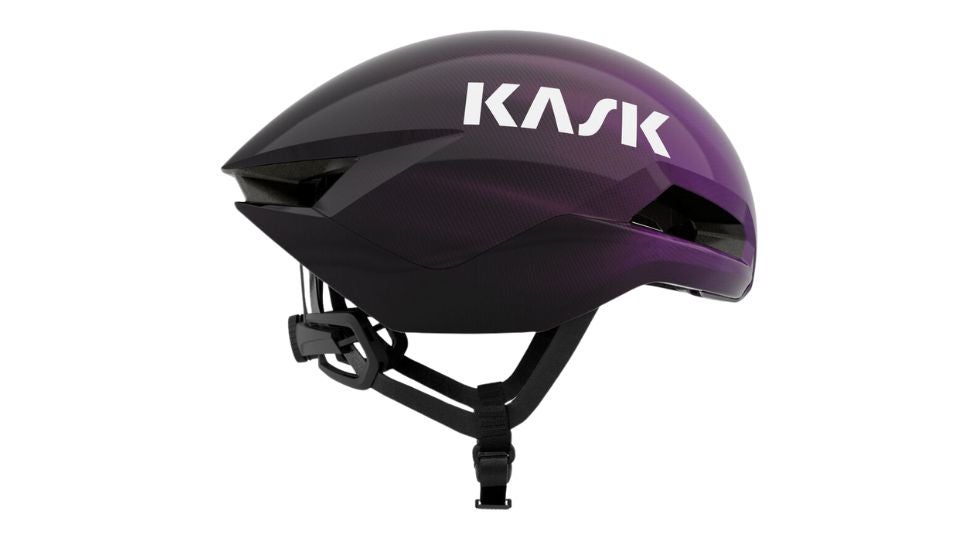
| Weight | 290g |
| MIPS | Yes |
| Fit & Adjustability | ★★★★★ |
| Comfort | ★★★★★ |
| Ventilation | ★★★★★ |
| Safety Features | ★★★★★ |
| Durability | ★★★★ |
| Sunglass Compatibility | ★★★★★ |
| Hearing | ★★★★★ |
| Value | ★★★★ |
| Overall | ★★★★★ |
The Kask Nirvana takes the light weight (290g) and compact design of a road helmet, but adds features typically only seen on aero helmet, like ear covers and a small rear tail. Testers especially liked the ear covers, which drowned out road noise while still allowing for situational awareness. But perhaps the most interesting thing about the Nirvana is the Multipod system, an integrated mesh that serves as a MIPS alternative for rotational impact protection while allowing for additional ventilation. There are also details that simply feel luxurious, like 3D-printed internal padding made of merino wool, leather chin strips, and high-visibility strickers. At $400, the helmet feels like an investment in one’s kit, but an investment worth making, especially when used for both training and racing.
Section dividerFizik Kunee TT
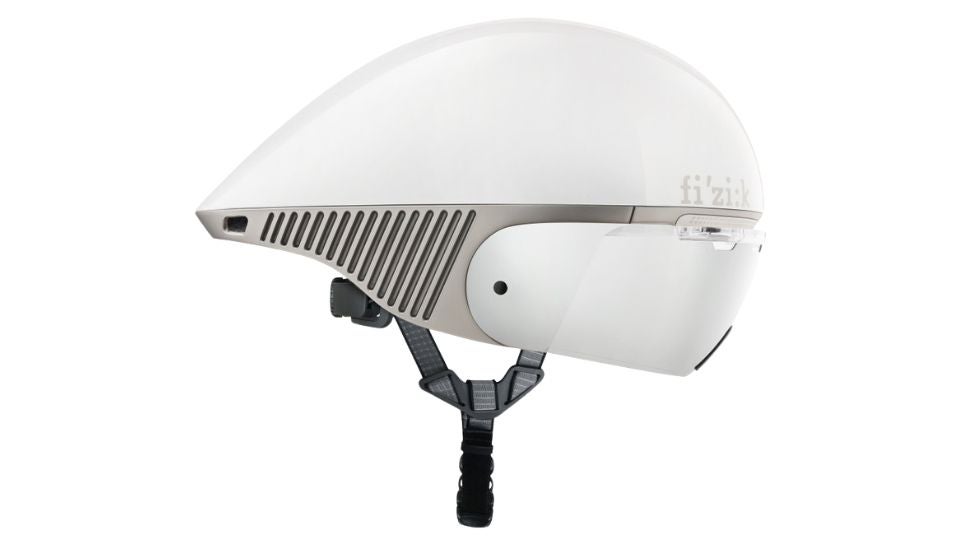
| Weight | 350g |
| MIPS | No |
| Fit & Adjustability | ★★★★ |
| Comfort | ★★★★ |
| Ventilation | ★★ |
| Safety Features | ★★★ |
| Durability | ★★★★ |
| Sunglass Compatibility | ★★★★ |
| Hearing | ★★ |
| Value | ★★ |
| Overall | ★★★ |
The Kunee, which comes in a traditional teardrop shape, pulled out all the stops in drag reduction including an integrated sun visor, corrugated side panels, and lightweight construction. Testers loved the ability to easily adjust the angle of the helmet by re-arranging the inner harness and chin strap, even on the fly. But the practical limitations of the helmet kept triathletes from fully endorsing the helmet for training and racing: in addition to poor ventilation causing heat buildup under the helmet, testers found the magnetic sun visor caused a significant amount of reflection of the rider’s own face, blurring the vision of the view ahead. That sun visor also added a challenge in transition, as the helmet cannot be removed with the visor attached, adding an extra step (and time) to transition. Also, though Fizik is compliant with CPSC safety standards, the Kunee is the one helmet in its line that does not have MIPS protection.
Section dividerSweet Protection Falconer 2VI

| Weight | 285g |
| MIPS | Yes |
| Fit & Adjustability | ★★★★★ |
| Comfort | ★★★★★ |
| Ventilation | ★★★★★ |
| Safety Features | ★★★★★ |
| Durability | ★★★★ |
| Sunglass Compatibility | ★★★★★ |
| Hearing | ★★★★ |
| Value | ★★★★★ |
| Overall | ★★★★★ |
Detail-oriented triathletes will appreciate the little touches Sweet Protection added to the Falconer 2VI, including a shock-absorbing impact shield for savvy, strategically-placed ventilation ports that flow over the superficial temporal arteries, a replaceable moisture-absorbing front pad to keep sweat out of the eyes, and even eyewear grippers for sunglass storage. Testers liked the versatility of the Falconer, saying it performed well in all conditions and accommodated a variety of men’s and women’s hairstyles, including braids and ponytails. The helmet also scored high marks for quick transitions and comfort. At an MSRP of $250, the Falconer 2VI holds its own against $300+ performance helmets – look for sales on limited-edition colors (as low as $180) to stretch your dollar even further.
